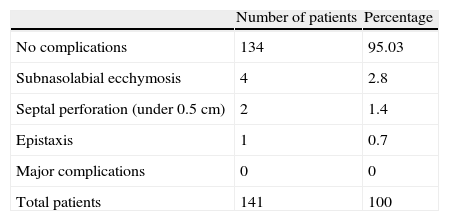The microdebrider is a surgical tool which has been used successfully in many endoscopic surgical procedures in otolaryngology. In this study, we analysed our experience using this powered instrument in the resection of obstructive nasal septum deviations.
Subjects and methodsThis was a longitudinal, prospective, descriptive study conducted between January and June 2007 on 141 patients who consulted for chronic nasal obstruction caused by a septal deviation or deformity and underwent powered endoscopic septoplasty (PES).
ResultsThe mean age was 39.9 years (15–63 years); 60.28% were male (n=85). The change in nasal symptom severity decreased after surgery from 6.12 (preoperative) to 2.01 (postoperative). Patients undergoing PES had a significant reduction of nasal symptoms in the pre- and postoperative period, which was statistically significant (P<.05). There were no statistically significant differences between the results at the 2nd week, 6th week and 5th year after surgery. All the participated patients were satisfied with the results of surgery and no patient answered “No” to the question added to compare patient satisfaction after surgery. Minor complications in the postoperative period were present in 4.96% of the cases.
ConclusionsPowered endoscopic septoplasty allows accurate, conservative repair of obstructive nasal septum deviations, with fewer complications and better functional results. In our experience, this technique offered significant perioperative advantages with high postoperative patient satisfaction in terms of reducing the severity of nasal symptoms.
El microdebridador es una herramienta quirúrgica que ha sido exitosamente utilizada en diversos procedimientos de cirugía endoscópica en otorrinolaringología. En el presente estudio se analiza nuestra experiencia en el uso de la instrumentación electromecánica en la reparación de las desviaciones obstructivas del septum nasal.
Materiales y métodosEste es un estudio descriptivo, prospectivo y longitudinal realizado entre enero y junio del 2007, sobre 141 pacientes que consultaron por obstrucción nasal crónica producida por desviación o deformidad del tabique, y que se sometieron a septoplastia endoscópica con instrumentación electromecánica (SEIE).
ResultadosLa edad media fue de 39,9 años (15-63 años) de los cuales, 60,28% fueron varones (n=85). El cambio en la gravedad de los síntomas nasales después de la cirugía descendió de 6,12 (preoperatorio) a 2,01 (postoperatorio). Los pacientes sometidos a SEIE tuvieron una reducción significativa de los síntomas nasales en el pre y postoperatorio y fue estadísticamente significativa (p<0,05). No hubo diferencias estadísticamente significativas en los resultados obtenidos entre la segunda y sexta semana, y al quinto año después de la intervención.
El 100% de los pacientes están satisfechos con los resultados de la cirugía, y ningún paciente respondió «No» a la pregunta añadida para conocer la satisfacción del paciente después de la operación. Complicaciones menores en el postoperatorio estuvieron presentes en un 4,96%.
ConclusionesLa SEIE permite una reparación correcta y conservadora de las desviaciones obstructivas del tabique nasal, con menos complicaciones y mejores resultados funcionales. En nuestra experiencia, esta técnica ofrece importantes ventajas intraoperatorias con una alta satisfacción postoperatoria del paciente en términos de reducción de la severidad de los síntomas nasales.








